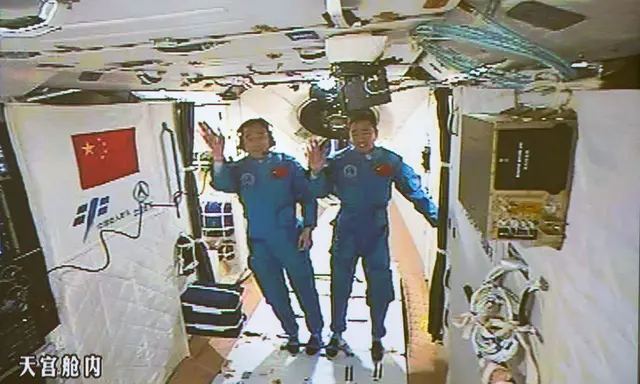The two astronauts aboard the Shenzhou-11 spacecraft entered the space lab Tiangong-2 at 6:32 Wednesday morning Beijing Time, according to Beijing Aerospace Control Center.
Commander of the mission Jing Haipeng opened the hatch of Tiangong-2 and floated into the space lab, followed later by Chen Dong.
The two astronauts extended greetings to all the people of the nation in the space lab, and checked the status of the space complex formed by Shenzhou-11 and Tiangong-2.
Photo taken on Oct. 19, 2016 shows the screen at the Beijing Aerospace Control Center showing the two Chinese astronauts Jing Haipeng and Chen Dong,R, preparing to enter the space lab Tiangong-2. Photo: Xinhua
Before entering the space lab, the two astronauts entered Shenzhou-11's orbital compartment and removed their intravehicular mobility unit spacesuits to change into blue jumpsuits.
After nearly two days of spaceflight, the Shenzhou XI conducted a computer-controlled docking with the space lab. Then the two astronauts-49-year-old Jing Haipeng and 37-year-old Chen Dong-will entered the lab and start the longest space stay by Chinese astronauts, according to the China Manned Space Agency.
Photo taken on Oct. 19, 2016 shows the screen at the Beijing Aerospace Control Center showing a simulated picture of an automated docking between the Shenzhou-11 manned spacecraft and the orbiting space lab Tiangong-2. Photo: Xinhua
During their 30-day mission in Tiangong II, the astronauts will carry out scientific experiments and research, including medical ultrasound examinations, weightlessness effects on cardiovascular functions and cultivation of plants as well as in-orbit repair, said Wu Ping, deputy director and spokeswoman for the agency.
The space lab, which was launched in mid-September, carries 14 scientific and experimental payloads, such as the world's first high-sensitive gamma-ray burst detector, which was codeveloped by engineers from China and the European Space Agency, she added.
Huang Weifen, deputy research head at the Astronaut Center of China, said that compared with previous space journeys by Chinese astronauts, the Shenzhou XI-Tiangong II mission will be the busiest because scientists planned more than 40 experiments and trials for it.
She said that an in-orbit brain-computer interaction test will be performed during the mission, aiming to verify a futuristic technology that will allow astronauts to control equipment with their thoughts rather than manually. This will be the first such experiment in the world.
Staff members work before the Shenzhou-11 manned spacecraft's docking with the orbiting space lab Tiangong-2 at the Beijing Aerospace Control Center in Beijing, capital of China, Oct. 19, 2016. Photo: Xinhua
"We hope that the mind-control, eye-control and gesture recognition technologies will be applied in our manned space station," Huang said, referring to a permanent space station that China plans to start building in 2018 and put into service around 2022.
However, before the astronauts embark on their tasks, they must strive to overcome a host of difficulties, experts said.
"No matter how realistic the ground training, it is difficult to simulate the real state of weightlessness in space," said Wang Ya'nan, editor-in-chief of the Aerospace Knowledge magazine.
"For astronauts, they experience a certain period of fullness in the head after the spacecraft enters orbit. They must get used to the weightlessness as soon as possible."
Shenzhou-11 was launched on Monday morning from northwest China's Gobi Desert.
(APD)
 简体中文
简体中文

